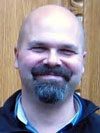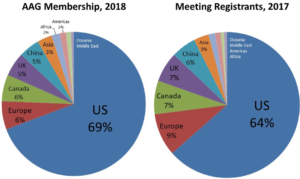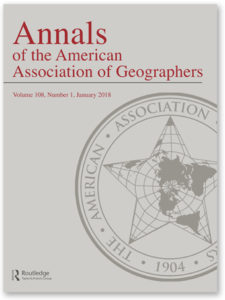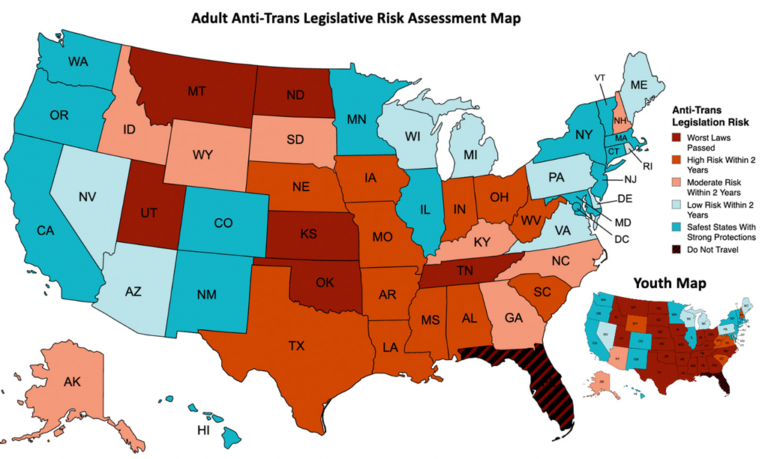Going Global or How Best to Recognize the Internationalization of the AAG; Plus – an Addendum to my Previous Column
 We have always been the “AAG” but five years ago the membership overwhelmingly decided to change the full title from the Association of American Geographers to the American Association of Geographers. I remember being part of the Council when this change was discussed. It went beyond verbal tweaking and reflected our best efforts to recognize that the AAG was no longer just an organization of U.S.-based geographers. Instead we had become a community in which geographers from many countries gather.
We have always been the “AAG” but five years ago the membership overwhelmingly decided to change the full title from the Association of American Geographers to the American Association of Geographers. I remember being part of the Council when this change was discussed. It went beyond verbal tweaking and reflected our best efforts to recognize that the AAG was no longer just an organization of U.S.-based geographers. Instead we had become a community in which geographers from many countries gather.
The value of internationalization was promoted especially by past President Kavita Pandit. In her columns, she recognized that higher education has become more international. With geography leading the way, we must welcome and validate students from around the world and incorporate study abroad curricula in our programs. Kavita was not alone in pointing to the importance of international geography. Past presidents such as Victoria Lawson, Ken Foote, and Derek Alderman, among many others have spoken to the need to extend our reach and our knowledge beyond national borders.
For me the internationalization of geography and of the AAG has been a godsend. Over 20 years ago I met a number of geographers from Finland who regularly attended the national meetings — resulting in long and fruitful collaborations that continue to this day. I have also collaborated with geographers from France and Italy who regularly partake in our yearly conference. And I am delighted to renew friendships each year with geographers from a whole host of different countries.
Unlike the International Geographical Union (IGU), the AAG is not structured as a super-organization made up of various national geographic societies. But we are growing ever more international and becoming a vital meeting space for geographers from around the world. In 2018, 3,476 members came from outside the United States, comprising 31 percent of all members. This is up from 22 percent international membership in 2013. The following charts show the breakdown by the largest countries and then by broad regions. International membership is led by Canada, China, and the United Kingdom, with over 90 other countries represented. Many of these geographers travel to our annual meeting to present and to network. Here the international presence is even greater, with fully 36 percent of attendees arriving from outside the United States.

This international presence adds tremendous value to our organization. This has been recognized already in several ways. We have implemented the Developing Regions initiative, which provides low-cost membership to geographers in several countries where access might otherwise be too dear. On the editorial side, we just selected two new Annals editors, both of whom work at institutions outside the United States. And about a quarter of our editorial boards are also international. What is more, I have been working with the presidents of the Canadian Association of Geographers and the European Association of Geographers to foster greater collaboration across national geographical societies.
We should move forward to the next level. Now is the time to consider international representation that better reflects our membership and puts force behind the meaning of our name change in 2015. For this reason, I am in favor of adding a dedicated international councilor, somebody who comes from an institution outside the United States. Right now international geographers have little representation. All U.S.-based geographers also belong to regional divisions, with their own regional councilor. Yet, with the exception of a few Canadian provinces folded into these AAG divisions such as NESTVAL, there is no dedicated representation for international members.
Why should we accord international members this special status? As with other groups, we could try to increase international representation through the nominations process, creating a larger pool of non-U.S. candidates for our existing “national” councilor and vice president slots. But this would be slow and unsteady — with few guarantees. In the last 10 years, we have had only two vice president and three councilor nominations from outside the United States. Of these, only past President Audrey Kobayashi from Canada was elected under our standard process.
Moreover, the AAG is intrinsically geographical in its own organization, befitting the nature of our field. Just as we divide the United States into nine geographical regions for the sake of governance, to bring an AAG experience closer to home and to represent the concerns of different parts of the United States, so we should pursue the unique advantages of recognizing the geographies of the one-third of our membership who do not live in any of these regions.
A dedicated international councilor would ensure that the AAG Council always has a representative from outside the United States. And while “international” encompasses the vastness of the world, there are relevant concerns that an international councilor could address and that would be common to members from Europe, Asia, Africa, and Latin America. Such concerns include the difficulties of access to U.S.-based meetings, potential linguistic issues, visa problems (particularly prevalent in this political environment), and better strategies for linking the AAG to geography societies around the world. I believe that an international councilor would add a great deal to our discussions and provide a hitherto underrepresented perspective.
While we have a team of people working on the particulars, I should emphasize that this reflects my personal views. The details behind creating this position will need to be worked out and approved by Council, and I will not go into them here. We may also consider a trial run, much as we did with our Student Councilor, so that we can see how well this idea works in practice and make modifications if need be. But make no mistake — the time has come to represent the international reach of our organization. The time has come to elect an International Councilor.
Addendum
As the latest in the lineup of AAG presidents charged with writing a weekly column, I would like to thank all of you who offer praise, reflections, insights, and corrections around the themes brought out each month. February’s column, Beyond the Academic 1 Percent, garnered more than its usual share of comments. Some of you noted omissions in my map of geography programs, which has been quite helpful in revising our comprehensive database of geography programs. Others agreed with the main premise of the column, in the need for greater institutional diversity and sympathy with the basic points.
There were also some critiques related to what was perceived by some as my denigrating geography at elite universities, especially Ivy League universities. My “unpopular” opinion was intended to be controversial and I will stick by my major view: the lack of large Ph.D. programs at Yale, Harvard, Princeton, and others has had some drawbacks, especially in regard to visibility — as many have pointed out over the years. But judging from the evidence among other disciplines, it has also had a salutary effect of making institutional geography more equitable. People can disagree about which is more important.
One thing we can all agree on, however, is the value of having strong geography programs at elite private institutions. Like all of you, I would like to see geography as an option for every undergraduate major. Many students tend to pick colleges first and then consider their majors, and it is a serious lapse not to have a geography degree among the options. Strong geography programs at colleges like Middlebury, Macalester, Vassar, and Mount Holyoke (to name just a few) should be encouraged and replicated across the country. The undergraduate geography program at Dartmouth College has been a true standout in this regard. Its faculty continue to contribute to the discipline while they introduce geography to legions of highly talented and demographically diverse students, who go on to become leaders in the field. These institutions are truly beacons in our geographical landscape, and our discipline would be a lot poorer without their presence and energy.
— Dave Kaplan
AAG President
DOI: 10.14433/2017.0069


